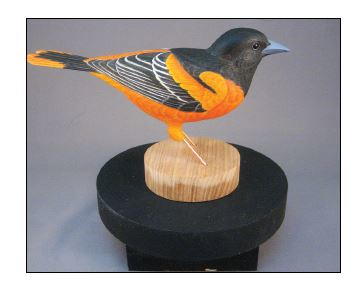A Baltimore Oriole, Part Two
Tom Park paints the oriole he carved for the Winter 2010 issue.

Once you’ve mounted the bird on the branch, touch-ups become more difficult, so I go over the bird carefully as a last step. I place the oriole on a turntable and turn it slowly at arm’s length as I look for areas that need attention. I find it useful to put the carving aside for a while and come back to it later. Often I find things that I missed on the first inspection.
In the last issue, I carved the Baltimore oriole, did the texturing and sealing, and finally coated the bird with gesso. I did the sealing with Deft brushing lacquer, after thinning it with lacquer thinner—60% Deft lacquer and 40% lacquer thinner. I used a fairly thin mix for the gesso coats. Rather than risk filling in the texturing, I opted for five thin coats.
The paints I used were acrylics from ChromaColour, Liquitex, and Golden. The color mixes described here are approximate percentages. I like to test the colors on white paper before applying them to the bird. Even then you might find that some adjustments are necessary after you apply the first coat.
I don't use a wide assortment of brushes. Basically, I work with a good wash brush (three-eighths inch for a bird this size), a one-half inch filbert brush, and two or three detailing brushes. My favorite brush for fine detail is the Leow-Cornel 7020 ultra round in #2 size. I like a slightly stiffer brush for the gesso coats so I can scrub the gesso into the texturing.
This article is from the Spring 2010 issue. For more information on our issues, check out our issues page.
Read NextPutting the Red in Red-Tailed



